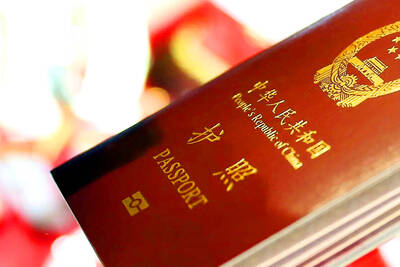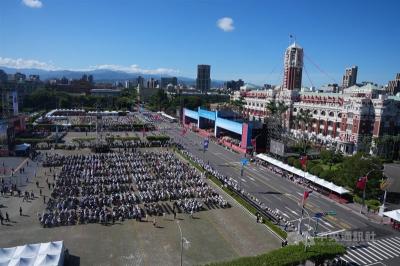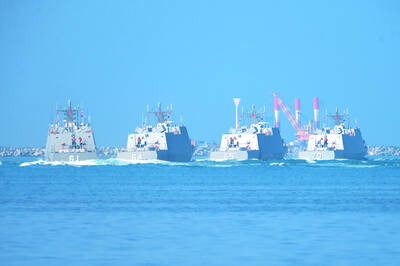President Ma Ying-jeou (馬英九) believes that if Chinese authorities acknowledge the existence of the Republic of China’s (ROC) Constitution, it would be conducive to maintaining peaceful cross-strait relations, Presidential Office spokesperson Charles Chen (陳以信) said yesterday in response to Chinese Minister of Foreign Affairs Wang Yi’s (王毅) public reference to the Constitution on Thursday.
Chen said Ma considers Wang’s remarks to be a demonstration of Beijing’s recognition of the existence of the Constitution.
“The Temporary Provisions Effective During the Period of Communist Rebellion (動員戡亂時期臨時條款) were abolished in 1991 and since then authorities on the mainland have no longer been viewed [by the ROC] as a rebel group. The National Assembly then amended the Constitution with changes collectively known as the Additional Articles (增修條文), acknowledging the governments on both sides of the Taiwan Strait as two equal political entities and legally dividing the ROC into the free region and the mainland region, which made possible the subsequent Act Governing Relations Between the People of the Taiwan Area and the Mainland Area (臺灣地區與大陸地區人民關係條例) that has facilitated the development of cross-strait relations,” Chen said.
Chen said the “1992 consensus” and “one China, different interpretations” are based on the cross-strait relationship established according to the Constitution.
Ma made it clear to Chinese President Xi Jinping (習近平) during their meeting in Singapore on Nov. 7 last year that the ROC’s position of “one China, different interpretations” based on the “1992 consensus” absolutely does not involve “two Chinas,” “one China, one Taiwan” or Taiwanese independence, as they are not allowed by the Constitution, Chen added.
“President Ma has emphasized this many times over the past few years, and his straightforward mention of the Constitution during his meeting with Xi was crucial, in the sense that it was unprecedented,” Chen said.
Chen attributed the unprecedented peace and prosperity in cross-strait relations and the “status quo” to the “1992 consensus” and “one China, different interpretations,” and called on “all ROC presidents” to cherish the achievements.
The so-called “1992 consensus,” a term former Mainland Affairs Council chairman Su Chi (蘇起) admitted making up in 2000, refers to a tacit understanding between the Chinese Nationalist Party (KMT) and the Chinese government that both sides of the Taiwan Strait acknowledge there is “one China,” with each side having its own interpretation of what “China” means.

The Ministry of the Interior (MOI) is to tighten rules for candidates running for public office, requiring them to declare that they do not hold a Chinese household registration or passport, and that they possess no other foreign citizenship. The requirement was set out in a draft amendment to the Enforcement Rules of the Public Officials Election and Recall Act (公職人員選舉罷免法 ) released by the ministry on Thursday. Under the proposal, candidates would need to make the declaration when submitting their registration forms, which would be published in the official election bulletin. The move follows the removal of several elected officials who were

The Republic of China (ROC) is celebrating its 114th Double Ten National Day today, featuring military parades and a variety of performances and speeches in front of the Presidential Office in Taipei. The Taiwan Taiko Association opened the celebrations with a 100-drummer performance, including young percussionists. As per tradition, an air force Mirage 2000 fighter jet flew over the Presidential Office as a part of the performance. The Honor Guards of the ROC and its marching band also heralded in a military parade. Students from Taichung's Shin Min High School then followed with a colorful performance using floral imagery to represent Taiwan's alternate name

FOUR DESIGNATED AREAS: Notices were issued for live-fire exercises in waters south and northwest of Penghu, northeast of Keelung and west of Kaohsiung, they said The military is planning three major annual exercises across the army, navy and air force this month, with the navy’s “Hai Chiang” (海強, “Sea Strong”) drills running from today through Thursday, the Ministry of National Defense said yesterday. The Hai Chiang exercise, which is to take place in waters surrounding Taiwan, would feature P-3C Orion maritime patrol aircraft and S-70C anti-submarine helicopters, the ministry said, adding that the drills aim to bolster the nation’s offshore defensive capabilities. China has intensified military and psychological pressure against Taiwan, repeatedly sending warplanes and vessels into areas near the nation’s air defense identification zone and across

A Chinese takeover of Taiwan would severely threaten the national security of the US, Japan, the Philippines and other nations, while global economic losses could reach US$10 trillion, National Security Council Deputy Secretary-General Lin Fei-fan (林飛帆) wrote in an article published yesterday in Foreign Affairs. “The future of Taiwan is not merely a regional concern; it is a test of whether the international order can withstand the pressure of authoritarian expansionism,” Lin wrote in the article titled “Taiwan’s Plan for Peace Through Strength — How Investments in Resilience Can Deter Beijing.” Chinese President Xi Jinping’s (習近平) intent to take Taiwan by force